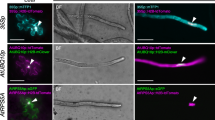Abstract
A very restricted amount of high-molecular-weight double-stranded RNA (dsRNA) has been found in healthy japonica rice plants. We discriminated dsRNA-carrying rice plants from noncarriers. The endogenous dsRNA was localized in the cytoplasm (about 100 copies per cell) and was transmissible to progeny plants by mating. In crosses between carriers and noncarriers, the RNA was transmitted efficiently to F1 plants via both egg and pollen. The rice dsRNA was maintained at an almost constant level by host plant cells from generation to generation. The high-efficiency transmission of the endogenous dsRNA to progeny plants appears to depend on the autonomously controlled replication of the dsRNA localized in cytoplasmic vesicles. However, an increase in copy number (about 10-fold) of the dsRNA was observed during the suspension culture of host cells. The number of copies of dsRNA returned to the original low value in regenerated plants, suggesting that the copy number is stringently and developmentally regulated in rice cells.
Similar content being viewed by others
References
Boccardo G, Lisa V, Luisoni E, Milne RG: Cryptic plant viruses. Adv Virus Res 32: 171–214 (1987).
Brown GG, Finnegan PM: RNA plasmids. Int Rev Cytol 117: 1–56 (1989).
Chase CD, Pring DR: Properties of the linear N1 and N2 plasmid-like DNAs from mitochondria of cytoplasmic malesterile Sorghum bicolor. Plant Mol Biol 6: 53–64 (1986).
Chu CC, Wang CC, Sun CS, Hsu C, Yin KC, Chu CY, Bi FY: Establishment of an efficient medium for anther culture of rice through comparative experiments on the nitrogen sources. Sci Sin 16: 659–688 (1975).
Dodds JA, Morris TJ, Jordan RL: Plant viral double-stranded RNA. Annu Rev Phytopath 22: 151–168 (1984).
Dodds JA, Valverde RA, Mathews DM: Detection and interpretation of dsRNA. In: Koltin Y, Leibowitz MJ (eds) Viruses of Fungi and Simple Eukaryotes, pp. 309–326. Marcel Dekker, New York (1988).
Fairbanks DJ, Smith SE, Brown JK: Inheritance of large mitochondrial RNA's in alfalfa. Theor Appl Genet 76: 619–622 (1988).
Fukuhara T, Moriyama H, Pak JK, Hyakutake H, Nitta T: Enigmatic double-stranded RNA in Japonica rice. Plant Mol Biol 21: 1121–1130 (1993).
Fukuhara T, Moriyama H, Nitta T: The unusual structure of a novel RNA replicon in rice. J Biol Chem 270: 18147–18149 (1995).
Ishihara J, Pak JK, Fukuhara T, Nitta T: Association of particles that contain double-stranded RNAs with algal chloroplasts and mitochondria. Planta 187: 475–482 (1992).
Kassanis B, Russell GE, White RF: Seed and pollen transmission of beet cryptic virus in sugar beet plants. Phytopath Z 91: 76–79 (1978).
Kenten RH, Cockbain AJ, Woods RD: Rothamsted Exp Stn Report for 1979, part 1, p. 188 (1980).
Lefebvre A, Scalla R, Pfeiffer P: The double-stranded RNA associated with the ‘447’ cytoplasmic male sterility in Vicia faba is packaged together with its replicase in cytoplasmic membranous vesicles. Plant Mol Biol 14: 477–490 (1990).
Mackenzie SA, Pring DR, Bassett MJ: Large double-stranded RNA molecules in Phaseolus vulgaris L. are not associated with cytoplasmic male sterility. Theor Appl Genet 76: 59–63 (1988).
Milne RG, Natsuaki T: Cryptoviruses. In: E-Singh RP, S-Singh U and Kohmoto K (eds) Pathogens and Host Specificity in Plant Diseases, vol 3, pp. 239–249 Pergamon, Oxford (1994).
Monroy AF, Gao C, Zhang M, Brown GG: Double-stranded RNA molecules in Brassica are inherited biparentally and appear not to be associated with mitochondria. Curr Genet 17: 427–431 (1990).
Moriyama H, Nitta T, Fukuhara T: Double-stranded RNA in rice: a novel RNA replicon in plants. Mol Gen Genet 248: 364–369 (1995).
Morris TJ, Dodds JA: Isolation and analysis of double-stranded RNA from virus-infected plant and fungal tissue. Phytopathology 69: 854–858 (1979).
Murashige T, Skoog F: A revised medium for rapid growth and bioassays with tobacco tissue cultures. Physiol Plant 15: 473–497 (1962).
Saltz Y, Beckman J: Chloroplast DNA preparation from Petunia and Nicotiana. Plant Mol Biol Newsl 2: 73–74 (1981).
Sorenson JC: In: Scandalios JG (ed) Molecular Genetics of Plants, pp. 109–149. Academic Press, London (1984).
Wang B, Li YN, Zhang XW, Hu L, Wang JZ: Double-stranded RNA and male sterility in rice. Theor Appl Genet 79: 556–560 (1990).
Wang ZY, Zheng FQ, Guo XL, Hong MM: Occurrence and partial characterization of an RNA species in rice mitochondria. Plant Sci 61: 227–234 (1989).
Zabalgogeazcoa IA, Gildow FE: Double-stranded ribonucleic acids in ‘Barsoy’ barley. Plant Sci 83: 187–194 (1992).
Zabalgogeazcoa IA, Cox-Fostre DC, Gildow FE. Pedigree analysis of the transmission of a double-stranded RNA in barley cultivars. Plant Sci 91: 45–53 (1993).
Author information
Authors and Affiliations
Rights and permissions
About this article
Cite this article
Moriyama, H., Kanaya, K., Wang, J.Z. et al. Stringently and developmentally regulated levels of a cytoplasmic double-stranded RNA and its high-efficiency transmission via egg and pollen in rice. Plant Mol Biol 31, 713–719 (1996). https://doi.org/10.1007/BF00019459
Received:
Accepted:
Issue Date:
DOI: https://doi.org/10.1007/BF00019459




